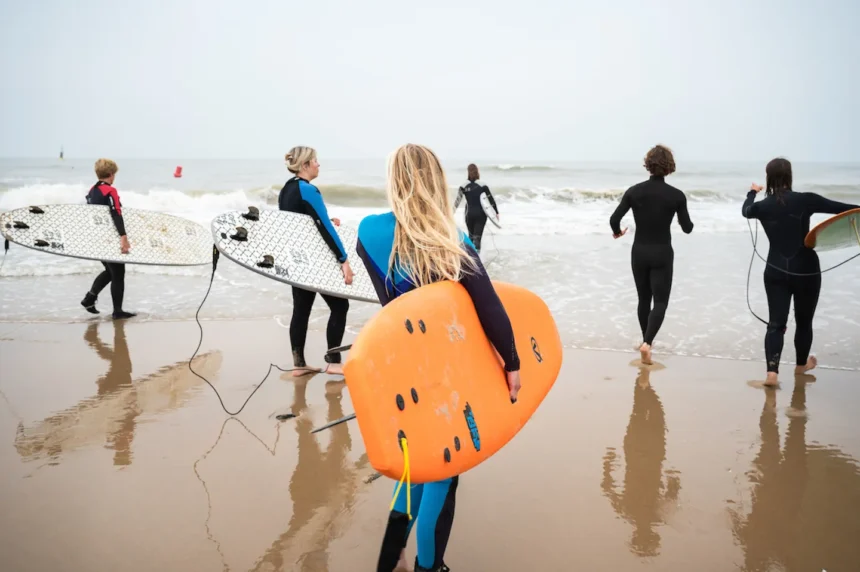Surfing is one of the most exciting water sports, but for beginners, the experience can be both thrilling and intimidating. One of the most critical factors in ensuring a smooth start is choosing the right beginner surfboard size. The right board can make learning faster, safer, and far more enjoyable, while the wrong board can lead to frustration or even injury. This article explores how to pick the perfect board, factors to consider, and insights from popular surfboard brands and experts.
Why Beginner Surfboard Size Matters
Choosing the correct beginner surfboard size directly impacts your stability, balance, and overall learning curve. For beginners, a board that is too short or too narrow can make catching waves difficult and lead to frequent falls. On the other hand, a board that is too large can be hard to manoeuvre but generally provides more stability.
The ideal surfboard size allows you to stand comfortably, paddle effectively, and maintain balance while riding small waves. Learning on a properly sized board builds confidence and accelerates skill development.
Key Factors in Selecting a Beginner Surfboard
When considering a beginner surfboard, it’s essential to evaluate several factors. These elements help determine which size and type of board will suit your body, skill level, and the conditions you’ll be surfing in.
1. Height and Weight
Height and weight are the two most important factors in determining the ideal beginner surfboard size. A general rule of thumb is that taller and heavier surfers require longer boards with greater volume for stability and buoyancy.
- Lighter surfers may find boards between 7’0 to 8’0 more manageable.
- Heavier surfers often need 8’0” to 9’0” boards to ensure balance and support.
While these ranges provide a starting point, individual comfort and paddling strength should also guide the final choice.
2. Skill Level
Beginners benefit from larger, more stable boards. Foam boards, commonly known as soft-top surfboards, are particularly beginner-friendly due to their buoyancy and forgiving surface. These boards allow new surfers to focus on balance and wave-catching without worrying about sharp edges or fragile fibreglass.
3. Board Type and Construction
- Foam (Soft-top) Boards: Best for absolute beginners. Safe, buoyant, and durable. Brands like Wavestorm and Catch Surf are popular in the USA for their quality foam boards.
- Fibreglass or Epoxy Boards: Offer better performance but are less forgiving for beginners. Suitable for surfers who plan to progress quickly. Brands like Channel Islands and Torq produce high-quality beginner-to-intermediate boards.
4. Wave Type and Surf Location
The kind of waves you’ll surf also influences your board choice. Small, slow waves are easier to ride on longer boards. In contrast, larger or faster waves may require more manoeuvrable boards. Beginners should prioritise stability over performance until they gain experience.
Beginner Surfboard Size Chart (Guideline)
Here is a simple guideline to help beginners choose the right board based on height and weight. Remember, these are recommendations; testing boards personally is always ideal.
Height (ft/in) Weight (lbs) Recommended Beginner Board Length
4’10” – 5’4” 90 – 130 7’0” – 7’6”
5’5” – 5’9” 131 – 160 7’6” – 8’0”
5’10” – 6’2” 161 – 200 8’0” – 8’6”
6’3”+ 201+ 8’6” – 9’0”
Volume (measured in litres) is also essential. Beginners usually require 50–60 litres for small riders and 60–80 litres for larger riders, but personal comfort and paddling strength matter.
Common Mistakes Beginners Make
Even with the right guidance, beginners often make mistakes that can slow learning:
- Choosing a Board Too Short Leads to difficulty balancing and catching waves.
- Ignoring Volume: Stability comes from the right combination of length and volume.
- Skipping Foam Boards: Some beginners opt for fibreglass too early, which increases the learning curve.
- Overlooking Wave Conditions: Surfing on unsuitable waves for your board can be frustrating.
Learning to avoid these pitfalls ensures a safer, more enjoyable experience.
Tips for Testing Your Beginner Surfboard
- Rent Before Buying: Try different board sizes at local surf shops. This allows you to feel the difference in stability and paddling ease.
- Balance Exercises: Practice standing on the board on sand or grass to improve balance before hitting the water.
- Observe Experienced Surfers: Notice how they position their boards, paddle, and pop up to stand learning from them is invaluable.
Competitor Insights
Popular surfboard brands in the USA for beginners include:
- Wavestorm: Affordable foam boards, widely used in surf schools.
- Catch Surf: Known for fun designs and beginner-friendly soft-top boards.
- Channel Islands & Torq: Offer performance-oriented boards that still cater to beginners looking to progress quickly.
Each brand has slightly different sizing recommendations, so it’s worth consulting multiple sources to see what aligns with your body type and goals.
Recommendations
For most beginners:
- Start with a foam board, around 7’0”–8’0”, depending on your weight and height.
- Focus on stability and paddling comfort rather than advanced performance features.
- Use local surf schools or rental boards to test before committing to a purchase.
Once confident, you can explore fibreglass or epoxy boards for better performance and more manoeuvrability.
Conclusion
Choosing the right beginner surfboard size is crucial for a successful start in surfing. By considering height, weight, skill level, wave type, and board construction, beginners can make informed decisions that enhance safety and enjoyment. Testing different boards, consulting trusted brands, and avoiding common mistakes will accelerate learning and make your first surfing experience memorable.
Remember, the right board is not just about size; it’s about comfort, stability, and confidence in the water. Start stable, progress steadily, and enjoy the ride





